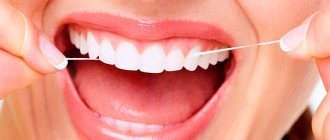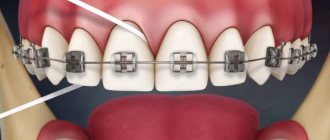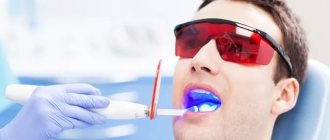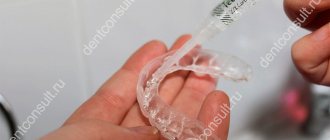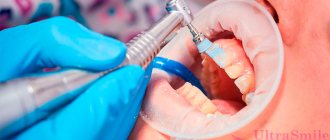Indications Advantages of use Contraindications How to use?
Dental floss and braces Types How to choose? If the floss gets stuck Brand rating For quality oral hygiene, just a brush with paste is not enough. Teeth have 5 surfaces, the brush effectively cleans 3 - anterior, lingual, chewing. The remaining 2 (cervical area, interdental spaces) need to be cleaned of plaque and food debris using additional hygiene products - dental floss or an interdental brush. And if, with dense interdental spaces, the effectiveness of a brush is in doubt, then the benefits of correctly chosen flosses are obvious. But many people don’t even know how to use dental floss correctly.
What is dental floss?
Floss is a special thread made of silk or polymer fiber for high-quality cleaning of the spaces between incisors, canines, premolars, and molars. It helps remove food particles in a similar way to a toothpick, but is much safer and more effective. The fibrous structure of dental floss makes it possible to gently and gently remove deposits from the enamel, preventing bacteria from multiplying and destroying hard tissue. The floss is placed between the teeth, cleaning first one side and then the other side of the dentition. It is important to know how to use dental floss correctly, otherwise the opposite effect will be obtained instead of benefit.
Frequent problems when using the accessory and ways to solve them
Let's look at the main difficulties that arise when cleaning interdental spaces with floss:
Dental brushes - how to use them
- Gums bleed when flossing. The symptom may indicate signs of developing gingivitis. Adults don't have to stop brushing their teeth right away. On the contrary, regular use of paste, brushes and floss suppresses the signs of dental diseases and reduces the intensity of their symptoms.
- Fiber stuck between teeth. To treat narrow interdental spaces, it is better to use Teflon or specially treated fishing line. In both cases, the floss will glide more easily over the enamel of the teeth. The dentist will help you choose the appropriate product option.
- Insufficient time for hygiene. On average, the procedure for cleansing your mouth with floss lasts 5 minutes. If you don't have enough time, you can reduce this time to 60 seconds. Even short-term treatment of interdental spaces will help avoid the development of caries.
- Coordination of movements is impaired. For people who have difficulty holding the thread, special devices with y-shaped support have been invented. One end of the thread is attached to the upper part of the structure, and the other to the hand.
In order for flossing to become a habit, you need to combine the procedure with pleasant activities: reading a book, watching your favorite TV show.
Dentists do not recommend flossing to all patients. The device is not suitable for people suffering from bleeding gums associated with periodontal disease. In this case, the product can aggravate the course of dental disease. In this case, floss can be used only after all signs of periodontal disease have disappeared.
When to use floss
There are different recommendations for how to use dental floss. Some experts believe that it is more effective to apply it before hygienic brushing, while others believe that floss is more effective after brushing with paste. There is no general scientific basis or clinical studies on this issue. The only important thing is the systematic use of dental floss.
Direct indication for flossing:
- crowded teeth;
- installation of approximal fillings;
- periodontal diseases;
- the presence of any non-removable orthodontic (braces), orthopedic (crowns, dentures) structures.
To maintain healthy teeth and gums, hygienic cleaning should be performed 2 times, daily, morning and evening. Flossing is part of oral hygiene. This product will finish the job where you can’t reach with a brush. Dental floss is recommended for everyone, without restrictions on age or structural features of the dental system. Flossing is needed for milk teeth, permanent teeth, and artificial teeth (crowns, dentures).
Flossing for Children
Children no earlier than 9 years old can use the accessory independently. However, you can introduce your child to the product much earlier.
It is important to teach your child good oral hygiene from an early age.
It is better for younger children to use the thread under parental supervision. It is important to ensure that the child carefully performs all manipulations and does not damage the gums and mucous membranes of the mouth. If during the process of cleaning the interdental spaces the baby’s gums begin to bleed, then the procedure is postponed and the mouth is washed with a warm antiseptic solution. You can resume flossing only after the bleeding has disappeared.
How to use: instructions
To use dental floss most effectively, you need to know the correct cleaning technology:
- Pull out a part of the floss 45-60 cm long. This length is enough to securely fix the thread on your fingers. Also, each dental unit is processed with a new part, so it is more convenient to initially take a longer floss.
- Twist the ends of the thread around your index or middle fingers. Make several turns, leaving a stretched part about 3 cm long between the thumbs. This part will be used to clean the contact surfaces.
- Gently insert the floss into the interdental space. After several light forward movements, the thread is inserted just below the gingival margin. Carefully move it up and down between the contact surfaces, around the tooth, slightly penetrating under the cervical area. Do not tug or pull the thread so as not to damage the mucous membrane and gum tissue.
- A similar procedure is repeated for all adjacent teeth. Cleaning begins with the upper row of teeth, then cleans the lower one. They move from the central incisors to the edges, in one direction or the other. To develop a habit, you should clean the segments according to the same principle each time.
- Moving on to the next tooth, move the floss using a new, clean part. To do this, move your fingers, rewinding the used segment.
- After cleaning, rinse your mouth with warm water or a special product. This will get rid of food particles, plaque residues, and provide fresh breath.
Do not make cutting movements or insert the thread deep under the gum, avoiding damage to the dentogingival attachment. When everything is done correctly, there is no discomfort or pain. After processing the dentition, the used floss is thrown away. Repeated use will provoke the spread of pathogenic microorganisms in the oral cavity, inflammation and other problems.
The first few days after flossing, your gums may bleed slightly. With regular cleaning, the bleeding stops on its own. But if during hygiene you constantly find bleeding gums, you need to go to the dentist for an examination and diagnosis.
Application algorithm for braces
After installing orthodontic structures, the doctor informs the patient about the rules for caring for them. To effectively clean devices, you must use brushes, toothbrushes, floss or irrigators. Food particles can easily get caught under hooks, locks and other elements of orthodontic structures, which cause bad breath.
The orthodontist teaches proper oral care using superfloss. This product performs the functions of several types of dental floss. The main point of training is to avoid damaging the structure itself and soft tissues during oral hygiene.
Photo of cleaning braces with floss
Algorithm for the procedure:
- Hands are treated with an antiseptic or washed with soap.
- The cleansing procedure is carried out in front of a mirror to examine all the elements of the orthodontic device.
- About 30 cm of thread is wound around the index fingers of both hands.
- The fiber is hooked under the main wire without touching the metal parts.
- After cleaning the braces, the accessory is hooked into each interdental space. To process closely spaced units, manufacturers make special narrow threads.
- The floss is removed from the mouth at one end to prevent damage to the braces.
- The used fishing line is disposed of.
Without floss, it is impossible to achieve ideal cleanliness of the oral cavity, especially with orthodontic devices installed.
How to floss with braces
For braces, there are superflosses with hard tips that clean not only the contact surfaces of the enamel, but also the elements of the corrective equipment. They easily pass areas above/under the arch, around the locks. The floss is inserted over the arch into the interdental space. When the thread is in the correct position, use gentle up and down movements to clean the enamel surfaces. All other adjacent surfaces of the dental units are cleaned in a similar way. The thread is used after cleaning with a brush or brush. A special orthodontic needle threader will make threading over the wire easier.
Detailed instructions for use
Those who regularly floss will confirm that cleaning between teeth is not difficult.
Carrying out this procedure does not take much time, you just need to master the technique:
- Unwind a piece 35-40 cm long from the reel (this length is enough for one procedure).
- Wrap most of it around the middle finger of one hand, and the remaining small part around the same finger on the other hand. A gap of 5-7 cm in length should remain unwound.
- To treat 1 tooth, it is enough to use a piece of only 2-3 cm. With a free finger, this piece is grabbed, stretched and carefully inserted into the gap almost to the gum.
- The floss is pressed against the surface being treated.
- Cleaning is performed in the following directions: from bottom to top on the lower jaw; to the cutting edges - on the chewing surface; from top to bottom on the upper jaw.
- Having processed one of the gaps, the segment changes. Make a turn on each finger (the used part is wound on the finger with less thread, and unwinded one turn from the other). The opposite side should be cleaned with a clean piece.
- The remaining gaps are processed using the same principle.
Tip: to achieve maximum cleansing effect, you must perform each movement at least 7 times for each tooth unit.
The video describes in more detail the correct use of interdental floss.
Kinds
Modern threads are made from silk or polymer fibers (nylon, nylon, Teflon, acetate). Floss is sold in special cassettes (from 10 to 100 m), providing hygienic storage and comfortable unwinding of the required length, thanks to the cutting edge under the lid.
Manufacturers also offer threads on a holder (flosser, dental machine). They are sold in several units per package. Some people choose a flosser, since its use eliminates the contact of hands with the oral mucosa and makes caring for eighth molars (wisdom teeth) easier.
Advantages
The procedure for using thread has a number of undeniable advantages:
- an affordable and fairly common remedy;
- effectively removes plaque and small food particles;
- completely cleans the interdental space;
- ease of use;
- the variety of shapes and materials allows you to choose the best option for yourself;
- strong and does not tear when used;
- applied impregnations disinfect the oral cavity and strengthen tissues;
- prevents the development of gum disease, inflammation, bleeding, and the formation of tartar;
- It is possible to perform oral hygiene anywhere without toothpaste and water.
Most of the benefits listed appear only after regular use of the thread. Therefore, it is important to get into the good habit of using it at least once a day to perform oral hygiene.
Watch the video for information about the benefits and rules for using floss.
What is the difference between dental floss?
Various types of thread are available for sale. Waxed, non-waxed, impregnated with silver, menthol, medicinal herbal extracts, as indicated on the package. Flosses are distinguished by cross-section, thickness, material, and processing.
According to sectional shape
- Round – recommended for large gaps between teeth;
- flat dental floss – efficiently removes deposits from crowded teeth and dense contact points;
- tape - for trema, diastemas.
By surface treatment
- Waxed - flosses treated with a thin layer of wax glide easily in the interdental space, are safe, suitable for gum disease, do not separate, simplify care;
- not waxed - they separate into fibers during use, the abrasive surface copes better with cleaning.
The difference between waxed and non-waxed dental floss is that the former penetrates between the teeth more easily, while the latter cleans the surface better.
By material
- Nylon - durable, strong, cleans contact surfaces efficiently, which makes them one of the most popular;
- silk dental floss - characterized by low mechanical tensile strength, therefore less and less are produced;
- nylon - reliable, strong, but less flexible than nylon models;
- acetate - elastic, soft, similar in characteristics to silk threads;
- Teflon - have the lowest coefficient of friction, quickly cope with dental plaque, the most expensive of all analogues.
All types of floss provide a similar effect. And the systematic, correct use of dental floss is more important than the brand, model or price.
What happens if you clean it incorrectly?
There is a category of people who consider brushing teeth to be a money laundering process, since a person absolutely does not need it. In particular, raw foodists who have given up eating thermally processed foods believe that hard fruits do a good job of cleansing. In addition, the teeth of herbivores, which do not suffer from caries and other dental problems, are used as an example.
This is a rather interesting, but unfounded approach. Of course, animals rarely lose teeth, but they are clearly far from ideal: it can be noted that the color of the enamel is yellow at best, and the breath from the mouth speaks for itself. But if we abstract from this situation, we can name several of the most serious and rapid consequences of refusing to brush your teeth:
- Plaque and tartar. Eating provokes the formation of a mucous film, which hardens quite quickly and hides the true color of the enamel.
- Bad breath (halitosis) is a consequence of active bacterial growth. In addition, over time, stuck food particles begin to rot, leading to caries and gum disease.
- Periodontitis. The slightest wound in the mouth will be the beginning of a whole chain of negative consequences. Bacteria, whose reproduction began due to unremoved food debris, will lead to inflammatory processes, ulcers and ulcers will appear. You may end up losing teeth, and your oral problems will not be solved by a dentist alone.
Infection of the gastrointestinal tract, problems with the throat and ligaments are also possible. This is not a complete list of what will happen if you brush your teeth incorrectly or refuse this procedure altogether.
How to choose
There are several main parameters by which dental floss is chosen. The first is size. The wider the interdental space, the larger the diameter of the floss needed. The second thing people pay attention to is the material, or rather the surface treatment. For beginners, it is better to choose a waxed thread, as it does not delaminate, easily enters the interdental space, and makes care easier. But floss without waxing removes deposits from hard-to-reach places better. People with braces and dentures should choose special models (superflosses), which do an excellent job of both cleaning between teeth and caring for elements of the orthodontic or orthopedic system.
Many patients are interested in what can replace dental floss. A good alternative is a flosser; it’s easy to use, you don’t need to monitor the length of the thread, and it’s easier to care for the outer teeth in a row. The irrigator does a better job of cleaning the periodontal sulcus, pathological pockets, and performs hydromassage of the gums, but it is not capable of cleaning the interdental spaces as efficiently as floss.
Indications for use
The device is great for removing plaque in hard-to-reach places where it is difficult for a toothbrush to reach. It is suitable for use by children from 8 years of age and adults.
Floss is suitable for regular daily use. The best way to use dental floss is every time after eating. It is also prescribed to patients with orthodontic appliances installed, as plaque and food particles accumulate faster on them.
Dental floss is a necessary oral care product for people with dental anomalies (trema and diastema, crooked teeth)
Why is it important to choose the right floss? First of all, the material should not delaminate when cleaning the interdental spaces. Floss breaks can occur if the tooth enamel has unevenness and chips.
What to do if the floss gets stuck
If dental floss gets stuck between teeth, you need to determine the cause. This happens if the size is incorrectly selected, if there are cracks, chips on the contact surface of the enamel or caries in this area. Another reason is tartar between the teeth, on which the floss clings, breaks, and as a result gets stuck.
To remove a stuck thread:
- rinse your mouth vigorously with water;
- rinse the interdental space with an irrigator;
- use a new thread to remove the problematic piece;
- use tweezers.
If these methods do not help, you should consult a doctor. Do not use needles, toothpicks, fishing lines, tines of forks or other sharp objects. This could result in serious injury. The dentist will remove the stuck piece quickly, without problems, using special tools.
Recommendations
Brushing teeth with braces
Before starting the procedure, you should wash your hands with soap. If it is difficult to pass the thread between the teeth, you need to purchase a coated model, which will greatly facilitate the passage of the thread between the teeth.
If you have braces, it is important to consult your dentist about the best cleaning method. The doctor will recommend special holder devices. Those who experience some discomfort should also seek professional advice from a dentist.
There is no consensus on when you should floss before or after brushing, but experts are unanimous that this should be done daily and especially before going to bed.
Choosing the right one
You can find several types of floss at the pharmacy. It should be chosen based on the anatomical features of the jaw structure (the size of the interdental spaces, the sensitivity of the gums, the condition of the enamel).
The floss itself is a nylon fiber twisted into a tight spool, which during operation is stratified into individual threads, thereby achieving the best effect. There are several varieties:
- They can be round or flat in shape . The former provide the best contact with the surface being cleaned, but cannot always penetrate into the most inaccessible places. Flat threads are designed for cleaning the smallest interdental spaces, when the teeth are in very close contact with each other.
- The surface of the floss can be waxed or unwaxed .
If you are just starting to use this device, then it is better to choose waxed floss. Its surface, treated with wax, remains uniform throughout the entire procedure, is in softer and more gentle contact with the enamel and surface of the gums and does not cause damage. At the same time, unwaxed floss has better cleaning properties. It is this that is stratified into individual fibers, which are used to process a large surface.
What types of attachments are there for an Oral Bee electric toothbrush and what are they used for?
In this article, you will learn the composition of Listerine mouth rinse.
Here: https://www.vash-dentist.ru/krasota-i-uxod/zubnyie-pastyi/opisanie-parodontaks.html - you can understand whether it makes sense to buy Parodontax toothpaste.
In addition, there are special threads impregnated with various compounds for the treatment and prevention of oral diseases. Depending on the disturbing factor, you can choose a thread that can strengthen the enamel, suppress the number of bacteria, and freshen breath.
Write a comment
Sashel
January 11, 2015 at 10:42 am
I am very surprised after reading this article... I didn’t know that it was so serious... bacteria in the oral cavity, for example, and that the floss still needs to be picked up. And that there are detailed instructions for use! Well done, they even made a video! Honestly, I didn’t even imagine that handling dental floss has certain rules and is a whole science... but you really need to take care of your dental health. I seriously thought about it, honestly... A very interesting and useful article.
Regina
February 25, 2015 at 8:42 am
My mother has false teeth; a regular brush does not always completely remove food particles from between the teeth. I decided to buy her dental floss, took the most inexpensive one, and didn’t even think about how to clean it properly. As a result, I damaged my gums, apparently I tried very hard. I’ll copy the article, it’s written very well, otherwise it’s impossible without a thread, but everyone needs to be able to use it correctly in order to avoid sad consequences.
Olga
May 9, 2015 at 11:15 pm
For me, my priority has always been a toothbrush. I only saw dental floss in a movie until a friend gave it to me. Very convenient packaging - miniature and flat, not even noticeable in your pocket. I didn't realize it came in different scents. They gave me a menthol flavored one. Everyone knows that if food gets stuck in a tooth, it brings a lot of inconvenience. This is where dental floss comes in handy.
Ksenia
August 12, 2016 at 03:29 pm
Only a couple of years ago, at an appointment with a dentist, I learned that dental floss is a necessary means of oral hygiene. Although it seemed to me just an addition. That same day, I went to the pharmacy, bought thread, and used it. Imagine my surprise when I saw how many food particles got stuck in the interdental spaces. And this was not a one-day occurrence, but a constant occurrence. So now I use it every day.
Tatiana
January 24, 2022 at 6:24 am
Very informative! How much have I learned now! I read it and found out for myself that I don’t really know how to use dental floss. But before I thought, I brush my teeth, floss - that’s all the care, what else is needed? Now, with the help of this article, I will master the art of proper use of dental floss for better cleansing of the oral cavity. I mainly use Oral-B or Colgate! Thank you very much for the visual material! I’ll also teach all my relatives how to do it!


